
Heated Nanoparticles Throw Gene Therapy Switch
September 12, 2014In a strategy known as gene therapy, scientists insert engineered DNA into diseased cells in order to treat or kill them. Now, researchers have combined nanotechnology and synthetic biology to create a simple switch to turn on such genes inside cells. They demonstrate that heat generated by magnetic nanoparticles activates the engineered genes, slowing tumor growth in mice (ACS Synth. Biol. 2013, DOI: 10.1021/sb4000838).
For gene therapy to reach clinical applications, such as for treating cancer, researchers need to activate their engineered gene sequences only in the diseased cells. That’s because in the course of introducing the synthetic genes, some healthy cells also may pick up the DNA packages. So to prevent activating synthetic genes in healthy cells, researchers want to design genetic circuits that can be triggered selectively.
Currently, there are only a few ways to do that, typically through applying drugs to the cells. Masamichi Kamihira of Kyushu University, in Japan, and his colleagues thought magnetic fields would be a more useful trigger. The fields travel deep into tissues and can be targeted to certain areas of tissue to avoid turning on genes in healthy cells.
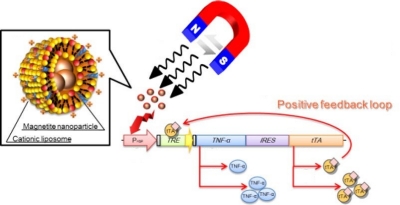 Magnetite nanoparticles surrounded by a cationic liposome (see above, left) generate heat when an alternating magnetic field is applied. Inside a cancer cell, the heat (thick red arrow) activates a promoter region (pink, P) in an engineered gene sequence containing instructions for a cell-killing protein (blue, TNF-α). The heat promoter also turns on a gene for a protein called tTA (orange) that activates a second response element (green, TRE) to continually express TNF-α. A sequence in-between (purple, IRES) ensures that both genes get translated into proteins.
Magnetite nanoparticles surrounded by a cationic liposome (see above, left) generate heat when an alternating magnetic field is applied. Inside a cancer cell, the heat (thick red arrow) activates a promoter region (pink, P) in an engineered gene sequence containing instructions for a cell-killing protein (blue, TNF-α). The heat promoter also turns on a gene for a protein called tTA (orange) that activates a second response element (green, TRE) to continually express TNF-α. A sequence in-between (purple, IRES) ensures that both genes get translated into proteins.
Biocomputing Based on Particle Disassembly
September 10, 2014
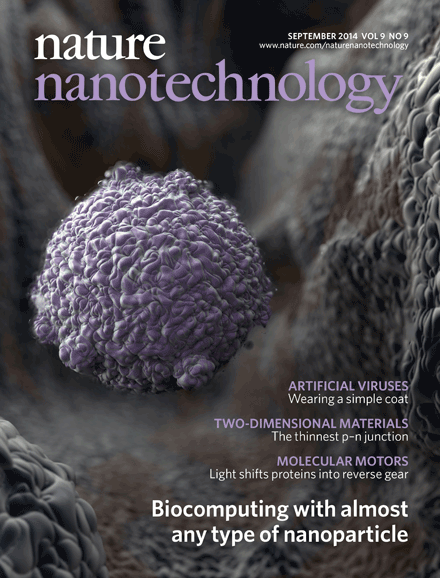 Maxim and Petr Nikitin and colleagues just published a beautiful paper in the September issue of Nature Nanotechnology. They were even chosen for the cover picture. Check their paper out here.
Maxim and Petr Nikitin and colleagues just published a beautiful paper in the September issue of Nature Nanotechnology. They were even chosen for the cover picture. Check their paper out here.
They explored the computing potential of particle-based systems. They were able to show that almost any type of nanoparticle or microparticle can be transformed into autonomous biocomputing structures that are capable of implementing a functionally complete set of Boolean logic gates (YES, NOT, AND and OR) and binding to a target as result of a computation. The logic-gating functionality was incorporated into self-assembled particle/biomolecule interfaces (demonstrated in their work with proteins) and the logic gating was achieved through input-induced disassembly of the structures. To illustrate the capabilities of the approach, they showed that the structures can be used for logic-gated cell targeting and advanced immunoassays.
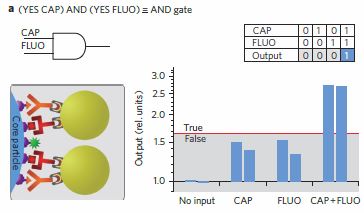
The proposed platform can be applied to the development of autonomous nanodevices as intelligent biosensors with built-in biochemical data analysis for multiplex point-of care diagnostics, field testing and so on. Furthermore, with the progress in metabolomics for the identification of new small molecule biomarkers, the platform could be used to construct bionanorobotic agents for complex stimuli-controlled targeted drug delivery, early diagnostics and health monitoring as a part of preventive medicine solutions.
A Blog About Biomagnetic Separation Full of Free Resources
August 30, 2014
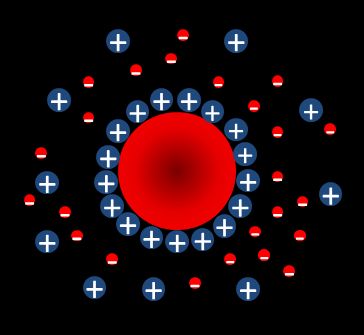 SEPMAG who develops, manufactures and markets advanced biomagnetic separation equipment has a very useful website. Their blog contains a wide collection of technical articles and covers all aspects of biomagnetic separation and related topics.
SEPMAG who develops, manufactures and markets advanced biomagnetic separation equipment has a very useful website. Their blog contains a wide collection of technical articles and covers all aspects of biomagnetic separation and related topics.
SEPMAG also offers an interesting collection of free ebooks and guides that provide in-depth insights into the most common applications of biomagnetic separation. The two most recent guides are The Advanced Guide to Biomagnetic Protein Purification and The Advanced Guide for the Use of Magnetic Beads in Chemiluminescent Immunoassays. Other guides will help to scale up or validate biomagnetic separation processes, or introduce newcomers to the area. These guides are totally free and can be downloaded by simply filling in a form with your name and email.
Nanomagnets Could Aid Study Of Hearing
July 25, 2014
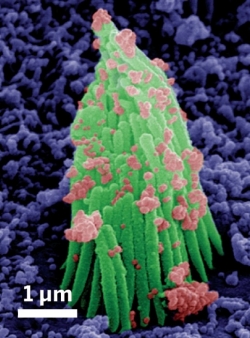 As people age, the tiny hairlike cells lining the inner ear can become damaged, leading to hearing loss. A new method that uses magnetic nanoparticles to stimulate these hair cells could help researchers better understand how the cells function and fail (ACS Nano 2014, DOI: 10.1021/nn5020616).
As people age, the tiny hairlike cells lining the inner ear can become damaged, leading to hearing loss. A new method that uses magnetic nanoparticles to stimulate these hair cells could help researchers better understand how the cells function and fail (ACS Nano 2014, DOI: 10.1021/nn5020616).
Some 16,000 hair cells line the cochlea in the inner ear, detecting motion produced by sound waves and transmitting electrical signals to nerves in a process that results in hearing. To understand how to protect or repair these cells, researchers must first understand how they work under normal circumstances. And so far, that process has been cumbersome and complicated.
Traditionally, researchers use a glass probe, attached directly to a hair-cell bundle, to physically push the bundle and stimulate the hair cells. Because the probe is so heavy, it adds mass to the delicate hairs in an uncontrolled way that can interfere with the experiment. “That loading could change what you’re measuring,” says Dolores Bozovic of the University of California, Los Angeles.
Bozovic and Jinwoo Cheon of Yonsei University, in Seoul, thought that magnetic nanoparticles could manipulate the hair bundles without adding extra load. They and their colleagues synthesized 50-nm-wide cubic nanoparticles from zinc and iron. They coated the particles with silica to increase their solubility in water and with polyethylene glycol to prevent them from clumping together. Then the researchers attached a protein called concanavalin A to the particles. This protein binds to glycoproteins on the surface of hair cells, which allowed the scientists to attach nanoparticles to hair cells taken from the ear of the North American bullfrog (Rana catesbeiana). By applying an oscillating magnetic field to a plate containing the ear cells, the researchers found that they could push and pull the nanoparticle-laden hairs at frequencies ranging up to 10,000 Hz. They recorded the movements with a high-speed camera and used software to determine the frequencies.
Magnetic drive of a medical micro robot in abdominal cavity
July 12, 2014Prof. Makoto Nokata has developed a new type of medical micro robot which can be driven around in the abdominal cavity using a magnetic force. The motion of the robot, move environment and the pictures from an internal camera were investigated in vivo using a simple prototype. The friction force between the abdominal wall and organs was measured, while the prototype model could be guided by simple magnetic field control. This internal micro robot might be a useful medical tool.
There are also a couple of movies about this magnetically directed robot on Prof. Nokata's website.
NIST Chip Produces and Detects Specialized Gas for Biomedical Analysis
June 29, 2014
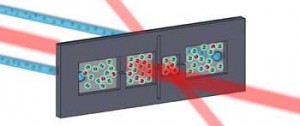 A chip-scale device that both produces and detects a specialized gas used in biomedical analysis and medical imaging has been built and demonstrated at the National Institute of Standards and Technology (NIST). The new microfluidic chip produces polarized (or magnetized) xenon gas and then detects even the faintest magnetic signals from the gas.
A chip-scale device that both produces and detects a specialized gas used in biomedical analysis and medical imaging has been built and demonstrated at the National Institute of Standards and Technology (NIST). The new microfluidic chip produces polarized (or magnetized) xenon gas and then detects even the faintest magnetic signals from the gas.
Polarized xenon, with the atoms’ nuclear “spins” aligned like bar magnets in the same direction, can be dissolved in liquids and used to detect the presence of certain molecules. A chemical interaction with target molecules subtly alters the magnetic signal from the xenon; by detecting this change researchers can identify the molecules in a complex mixture. Polarized xenon is also used as a contrast agent to enhance images in experimental magnetic resonance imaging (MRI) of human lungs, but conventional systems for producing and using this gas can be as big as a car.
Researchers from NIST and three other institutions developed the new chip, which might be used to reduce the size and cost of some instruments that, like MRI, rely on nuclear magnetic resonance (NMR). The chip’s sensitive internal detector boosts the response of microfluidic NMR on small samples and eliminates the need for the powerful magnets associated with larger NMR devices such as those used in MRI. The microfabricated chip could be mass produced and integrated easily with existing microfluidic systems.
For more information, check this link.
New Grant Network: Magnetic Hyperthermia and Radiotherapy (RADIOMAG)
May 31, 2014A new network grant has recently been approved in Europe, the TDCOST Action TD 1402: Multifunctional Nanoparticles for Magnetic Hyperthermia and Indirect Radiation Therapy (RADIOMAG)
The Action aims to bring together and to organise the research outcomes from the different participating network members in a practical way to provide clinicians with the necessary input to trial a novel anti-cancer treatment combining magnetic hyperthermia and radiotherapy, also identifying future research objectives upon appraisal of the obtained results. Feedback between the different working groups here is essential, and is expected that the lifetime of this Action proposal will eventually result in a compendium of best practices for magnetic hyperthermia.
RADIOMAG will generate new and strengthen the existing synergies between technical advances (thermal imaging / MH), new treatment concepts (combined targeting radiosensitisation and magnetic thermotherapy) and biocompatible coating in order to achieve a breakthrough in the clinical application of magnetic hyperthermia. Due to the complexity of this aim, synergies can only be achieved on a longer time frame, by means of workshops, STSMs, joint publications, common Horizon 2020 research proposals and exchange with other COST Actions (e.g. TD1004, TD1205).
http://www.cost.eu/domains_
Guidelines for Dynamic Light Scattering Measurements and Analysis
May 26, 2014The company Nanocomposix published a very good introduction into particle size measurement with dynamic light scattering (DLS) measurement. After analyzing thousands of nanoparticle samples they have assembled a set of guidelines that can be used to determine how to maximize the quality of your DLS data and, more importantly, how to interpret your results. Check it out here. And if you have more questions, contact them at info@nanocomposix.com or (858) 565-4227 x 2.
For more information, check out our Archives.
September 2017
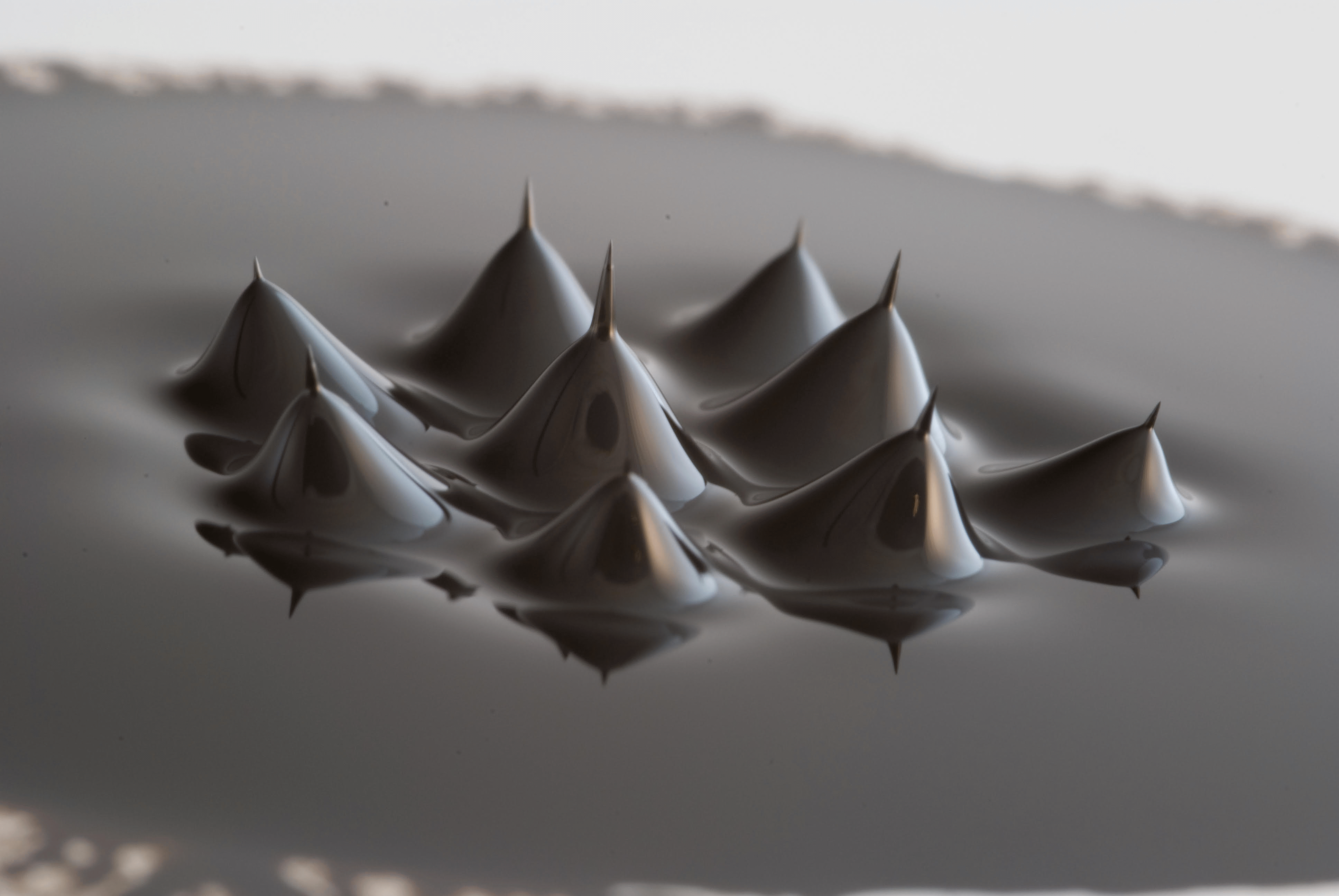
Search this site with the power of

